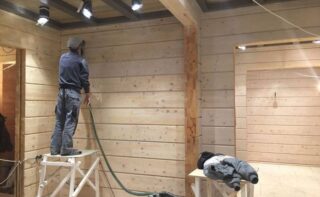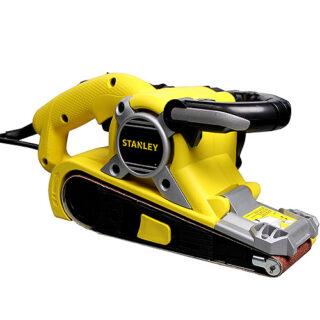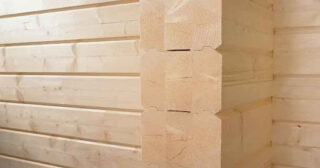The construction of a solid wood building is a multi-stage process, one of which is the laying of walls. At this stage, special attention is paid to the tightness of seams and joints. After arranging the roof, floor of windows and doors, sanding begins. The event is held when property owners decide not to close the walls, but to keep them in their natural form. Grinding a house from a bar is a responsible, delicate, but not so complicated procedure that it cannot be done with your own hands. It is enough to familiarize yourself with the features, nuances, rules for its implementation and acquire the appropriate equipment.
The need to grind the timber inside the house

The concept of sanding means mechanical processing of wood in order to eliminate existing surface defects, giving it smoothness and a uniform color shade. This work is carried out at various stages of the building's operation - immediately after raising the frame, after drying out, during major repairs, as well as to remove the darkened outer layer.
Grinding the timber inside the house is carried out in order to solve the following problems:
- Leveling the surface. As a rule, the level difference of the crowns is up to 2-3 mm. A smooth wall looks better, it is easier, faster and more economical to process it.
- Elimination of irregularities that appear on the timber during the manufacture, transportation, installation and subsequent activities of workers.
- Refreshing the appearance. Over time, the wood darkens, takes on an uneven shade, becomes stained. Correct processing makes it lighter, more beautiful and richer.
- Elimination of the consequences of soaking with antiseptics, preparation for the next treatment. In the purified material, liquids are absorbed better and penetrate deeper.
The highest quality woods undergo more delicate processing, but even on their surface traces of mechanical stress remain. Therefore, you will have to grind it one way or another.
Grinding tools and equipment

In order to qualitatively grind a log house from the inside from the outside, you will need a set of general fixtures and special equipment.
Standard set of tools:
- level;
- knife;
- chisel;
- paint brush;
- ladder;
- extension;
- hard sponge;
- a vacuum cleaner;
- sandpaper.
It is theoretically possible to carry out manual grinding. But it will be weeks of hard work with low output. It is advisable to spend money, but get quality fixtures. They will be required more than once in the future. It is even better to acquire a set of tools that will allow you to quickly and efficiently process the entire surface of the walls with their hard-to-reach places.

It is recommended to have such equipment:
- Angle grinder (grinder) with a set of attachments of various sizes and configurations. Without fail, the technique must have a speed controller. When rotating with standard machines at a speed of 1100 rpm, the wood burns, there is a high probability of grinding off excess, the formation of stripes and furrows.
- Belt sander. The product is powerful, heavy, low-speed, provides a large area of mechanical coating. The risk of damage is minimized, but the processing speed is also lower than that of angle grinders.
- Vibration grinder.It has a narrow specialization, it is used for finishing polishing, processing corners and joints, and other places where other devices cannot get.
When carrying out work, it is necessary to use glasses, gloves and a respirator.
Rules for grinding timber inside the house

In the presence of serviceable and functional equipment, internal grinding of walls will not be accompanied by serious problems, provided that the following rules are observed:
- Wood processing is carried out after drying to a level of 17% or less. Otherwise, the wet pile that is not on its surface will not be erased, and with a decrease in the internal humidity of the bar it will rise.
- The dust generated during polishing is explosive. To prevent a fire, you need to use an industrial vacuum cleaner or use a tool that does not produce sparks. As a last resort, effective ventilation should be organized so that the waste is pulled out into the street.
- It is advisable to work from top to bottom. This way, previously treated rooms can be kept clean.
- Before starting sanding, it is necessary to check the walls with a level, draw up a diagram, and transfer it to the surface. The alignment is best done in stripes, starting with the most prominent links.
- Correctly organized lighting. Light must fall on the plane at a slight angle in order to see all defects. A desk lamp is used if necessary.
- Neat and intelligently routed cables. The likelihood of their getting into the working bodies of construction equipment, as well as twisting and creasing, should be excluded.
- Surface preparation. Conifers give off resin. This substance instantly clogs the abrasive attachments. The resin must be scraped off in advance and melted out of the pockets with a construction hairdryer.
The surface of the polished timber quickly darkens. In order not to redo the work, you need to prepare in advance an antiseptic, impregnation, varnish or mastic in order to apply them on fresh material.
Wall processing technology

Grinding of walls from a bar is carried out in the following sequence:
- Rough (primary) processing. The task of the process is to remove irregularities, dirt, grind the edges of the dents to a gentle state, when they will not be noticeable. Grinding of the material is done with abrasive nozzles with the largest grains. Work begins with No. 40, gradually reducing the size to No. 80. It should be borne in mind that the nozzles will quickly clog, so you need to have a substantial supply of abrasive material.
- Finishing (main) grinding. It is carried out for the final leveling of surfaces, bringing them to a glossy shine. Fine abrasive no. 120-180 is used, as well as polishing brushes that bring the final gloss and remove dust from joints and corners. Difficult areas are straightened with a knife, chisel and fine sandpaper.
- Cleaning planes. After polishing, they are covered with a layer of dust and fine chips. The best way to remove them is an industrial vacuum cleaner. If it is not there, the work can be carried out with a sponge soaked in an antiseptic, solving two problems at once.
When planning the processing of walls, you need to take into account the properties of the material from which they are laid out. Massive, including profiled timber, must go through a full leveling cycle. Glued-type products have a finer processing, plus they are not so susceptible to shrinkage. Therefore, for them, in the absence of significant defects, only finishing polishing can be used immediately after the surface has hardened.
Typical mistakes when working

Lack of experience, which is characteristic of novice developers, is a prerequisite for making mistakes that affect the quality of the final result, delay and complicate the entire process as a whole.
The most typical errors are:
- Excessive force when working with tools, which leads to the grinding of excess material, the formation of grooves and depressions.
- Ignoring the removal of resin, which, once smeared over the surface, makes the task much more difficult.
- Wetting wood. As a result, the abrasive slides along it, creating a large amount of pile.
- Savings on the purchase of tools. Low-power equipment is difficult to work with, it breaks down and fails more often. The other extreme is heavy technique, from which the master quickly gets tired and makes inaccuracies.
- Haste, when the processing of raw timber is carried out, which has practically no effect.
- Tightening with fresh surface treatment with protective coatings when it darkens and a new polish is required.
Grinding the timber will be successful if done on time, correctly, with high-quality and convenient tools.









Hello. The profile bar itself is polished, it is not necessary to grind, the bar is not covered with anything inside the house that has not yet been seen not to deteriorate.